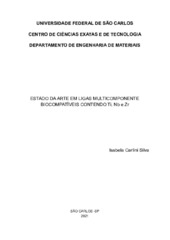| dc.contributor.author | Silva, Isabela Carlini | |
| dc.date.accessioned | 2022-04-05T11:02:29Z | |
| dc.date.available | 2022-04-05T11:02:29Z | |
| dc.date.issued | 2021-11-19 | |
| dc.identifier.citation | SILVA, Isabela Carlini. Estado da arte em ligas multicomponente biocompatíveis contendo Ti, Nb e Zr. 2021. Trabalho de Conclusão de Curso (Graduação em Engenharia de Materiais) – Universidade Federal de São Carlos, São Carlos, 2021. Disponível em: https://repositorio.ufscar.br/handle/ufscar/15805. | * |
| dc.identifier.uri | https://repositorio.ufscar.br/handle/ufscar/15805 | |
| dc.description.abstract | The present work aims to study biomaterials that are used in implants, aiming to understand the potential of titanium alloys containing stabilizing elements such as niobium and zirconium, these elements improve mechanical properties and biocompatibility with human bone. Quaternary and ternary alloys will be addressed, illustrating this potential for improvement. Alloys containing these elements showed a significant reduction in the elastic modulus of titanium alloys compared to Co-Cr alloys, Stainless Steel 304 and 316 and Ti-64 Alloys, which is an important property for the implant to behave similarly. to human bone, which has a modulus of approximately 17 GPa. In addition, titanium alloys are the best for acquiring the mechanical and chemical properties to which the implant will be requested. The Ti-13Nb-6Ta-7Zr and Ti-7Nb-6Ta-13Zr alloys have a modulus of elasticity of 46 GPa, being very suitable for an implant, in addition to having excellent hardness and corrosion resistance properties. The Ti-13Nb-13Zr alloy. | eng |
| dc.description.sponsorship | Não recebi financiamento | por |
| dc.language.iso | por | por |
| dc.publisher | Universidade Federal de São Carlos | por |
| dc.rights | Attribution-NonCommercial-NoDerivs 3.0 Brazil | * |
| dc.rights.uri | http://creativecommons.org/licenses/by-nc-nd/3.0/br/ | * |
| dc.subject | Biomateriais | por |
| dc.subject | Titânio | por |
| dc.subject | Nióbio | por |
| dc.subject | Zircônio | por |
| dc.subject | Implantes | por |
| dc.subject | Ligas de Ti-beta | por |
| dc.subject | Biomaterials | eng |
| dc.subject | Titanium | eng |
| dc.subject | Niobium | eng |
| dc.subject | Zirconium | eng |
| dc.subject | Implants | eng |
| dc.subject | Ti-beta alloys | eng |
| dc.title | Estado da arte em ligas multicomponente biocompatíveis contendo Ti, Nb e Zr | por |
| dc.title.alternative | State of the art in biocompatible multicomponent alloys containing Ti, Nb and Zr | eng |
| dc.type | TCC | por |
| dc.contributor.advisor1 | Coury, Francisco Gil | |
| dc.contributor.advisor1Lattes | http://lattes.cnpq.br/8609825406277730 | por |
| dc.description.resumo | O presente trabalho tem como objetivo estudar os biomateriais que são utilizados em implantes, visando compreender o potencial das ligas de titânio contendo elementos estabilizadores como nióbio e zircônio, estes elementos que melhoram as propriedades mecânicas e a biocompatibilidade com o osso humano. Ligas quaternárias e ternárias serão abordadas, ilustrando esse potencial de melhorias. As ligas contendo estes elementos mostraram uma significativa redução no módulo de elasticidade das ligas de titânio em comparação com ligas Co-Cr, Aço Inox 304 e 316 e Ligas Ti-64, esta que é uma propriedade importante para que o implante possa se comportar similar ao osso humano, que possui um módulo de aproximadamente 17 GPa. Além disso, as ligas de titânio são as melhores para aquisição das propriedades mecânicas e químicas ao qual o implante estará sendo solicitado. As ligas Ti-13Nb-6Ta-7Zr e Ti-7Nb-6Ta-13Zr possuem o módulo de elasticidade de 46 GPa, sendo muito adequado para um implante, além disso tem ótimas propriedades de dureza e resistência à corrosão. A liga Ti-13Nb-13Zr
apresentou um valor de 635 MPa, que já é superior ao da liga Ti-6Al-4V, para resistência à fadiga. | por |
| dc.publisher.initials | UFSCar | por |
| dc.subject.cnpq | ENGENHARIAS::ENGENHARIA DE MATERIAIS E METALURGICA::METALURGIA FISICA | por |
| dc.publisher.address | Câmpus São Carlos | por |
| dc.publisher.course | Engenharia de Materiais - EMa | por |

